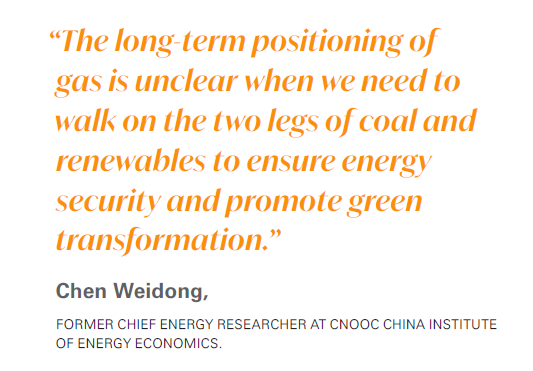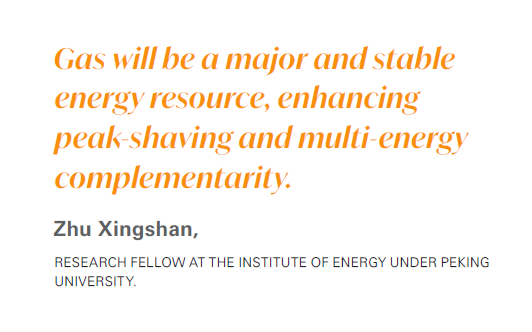Experts cast doubt on future role for gas in China [Gas in Transition]
Two LNG supply megadeals clinched by China’s state energy giants in the past eight months would appear to be ample evidence that the long-term growth story for Asia’s biggest gas market remains intact. But discussions at a recent LNG conference were less certain as veterans of China’s energy industry warned gas demand growth could slow more than expected as coal and renewables gain ground.
CNPC confirmed on June 20 it had signed a 27-year sales and purchase agreement (SPA) with state-owned QatarEnergy for 4mn metric tons/year of LNG starting in 2026. CNPC will take a 5% equity stake in an 8mn mt/yr production train at Qatar’s massive North Field East (NFE) expansion project to complement the SPA, heralding the entry of China’s biggest energy company as a partner in the world’s biggest LNG export project.
The announced terms are identical to a SPA signed by Sinopec last November. Both deals represent the longest-duration contracts ever signed by QatarEnergy – by the time they expire in 2053 there will be just seven years to go until China’s self-imposed deadline to reach carbon neutrality by 2060. All in all CNPC and Sinopec will receive a combined 216mn mt of LNG over the lifetime of the contracts – exceeding what China has imported for the past three years.
Lingering doubts
The length of the SPAs suggests China – running ahead of Japan as the world’s biggest LNG importer so far this year – has no concerns about the durability of domestic gas demand in the long run. But speakers at the China International LNG Conference & Exhibition, held in Shanghai in mid-June, were more circumspect about the long-term outlook.
Chinese gas demand is slowing as coal and renewables become more reliable in the face of global supply insecurity and volatile costs, according to Tian Lei, deputy director of the Energy Strategy Center under the Chinese Academy of Macroeconomic Research.
Consumption growth – which recorded double-digit percentage increases in six of the past 12 years – is likely to slow to 5% annually through 2025 before shrinking to 4% through 2030 and 2% through 2040, said Tian, who is affiliated with the National Development and Reform Commission (NDRC). “Price is the key to how much gas can grow,” he added.
Coal and renewables are the “two legs” that China needs to make sure it does not stumble on its path to an energy transition, according to Chen Weidong, former chief energy researcher at CNOOC’s China Institute of Energy Economics.
Coal is needed for energy security because the nation has ample resources – unlike oil and gas – while companies still need to speed up deployment of wind and solar to help meet the country’s climate targets, Chen said. “The long-term positioning of gas is unclear when we need to walk on these two legs to ensure energy security and promote green transformation,” Chen said.
The uncertainty over how much gas China can consume was underlined by divergent demand forecasts at the conference. Chinese gas demand will peak at around 2040 at 615.5bn m³ and the country will still be consuming 390bn m³ by the time President Xi Jinping’s carbon neutrality deadline of 2060 arrives, according to forecasts from Sinopec’s Economics & Development Research Institute.
These projections were more conservative than those from Xie Xuguang, chief analyst at CNOOC’s gas and power group, who predicted that China would consume 628bn m³ by 2035 and 700bn m³ by 2040.
Gas going nowhere
Other speakers insisted that long-term prospects for gas in China have not diminished even as the country ramps up coal consumption and works to build a new energy system underpinned by renewables.
Gas remains “indispensable” as China builds its new energy system, according to Zhang Yuqing, former deputy director of the National Energy Administration (NEA). While Chinese gas consumption declined last year due to slower economic growth and high prices, “in the long run, gas – as a replacement fuel for high-carbon emission fuels – has the advantages of stable supply and technology development, and consumption will continue to grow,” Zhang said at the conference.
The share of gas in China’s total energy consumption dropped last year for the first time in a generation, to 8.5% from 8.8% in 2021. Bullish forecasts in December and January tipped gas demand and LNG imports to bounce back after China’s surprisingly abrupt exit from the COVID-19 pandemic, but they have not lived up to lofty expectations so far.
Apparent consumption stood at 31.79bn m³ in April, an annual increase of 7.3% that was nonetheless a deceleration from growth of 9.3% in March, according to the latest figures from the NDRC. January-April demand climbed by 4.1% on the year to 129.26bn m³, but this was flattered by a weak base comparison as the same four months of 2022 were disrupted by COVID-19 lockdowns in Shanghai and other cities.
“While there were several factors for weak gas demand last year, I think spiking gas prices played a more important role than the weak economy in lowering end-user gas consumption last year. Gas prices were too high last year,” said Yu, a suggestion that China remains a price-sensitive market.
Coal, renewables gain ground
Gas will remain critical as China tries to balance its needs for energy security with long-term efforts to decarbonise, but it has lost ground to coal and renewables – both of which have far more robust domestic supply chains – acknowledged Zhang, now a professor at the China Business Executive Academy. At the same time China has ample proven gas reserves underground, suggesting a large potential for domestic output to grow even further, Zhang added.
 China had 6.57tn m³ of technically recoverable gas reserves at the end of 2022, implied by year-on-year changes released by the Ministry of Natural Resources on June 14. At last year’s rate of production of 218bn m³, the reserves-to-production ratio stood at just above 30 years – down marginally from nearly 31 years in 2021.
China had 6.57tn m³ of technically recoverable gas reserves at the end of 2022, implied by year-on-year changes released by the Ministry of Natural Resources on June 14. At last year’s rate of production of 218bn m³, the reserves-to-production ratio stood at just above 30 years – down marginally from nearly 31 years in 2021.
While gas burn remains soft nearly midway through 2023, it is shaping up to another robust year for coal in China. Domestic output is running almost 5% ahead of last year’s record. Imports have soared by 90%, and shipments are flooding in from as far afield as South Africa and Colombia.
In the face of geopolitical tensions and extreme weather, Beijing is not taking chances with supply. Coal is so abundant right now that it is weighing on prices, with the cost of thermal coal traded at Qinhuangdao port recently falling to its lowest since April 2021.
China will ensure coal and gas supply to meet power generation demand in the summer, NDRC spokesperson Meng Wei said on June 16. The NDRC will push power plants to keep coal inventories at relatively high level, with reserves at major power plants already at a record high of 187mn mt.
Gas in China’s renewables era
The competitiveness of gas in China could be further squeezed by the country’s rapid deployment of solar and wind power as part of efforts to build a new energy system with renewables at its core. In January the NEA proposed a timetable for the construction of the new system, with 2030, 2045 and 2060 regarded as three important dates.
From now until the end of this decade will be regarded as an accelerated transition period for adopting clean and low-carbon energy, during which non-fossil fuels will make up one-quarter of total energy consumption. New energy – a term that Beijing has yet to officially define but understood to include wind, solar, biomass, geothermal and hydrogen – will be developed on utility and distributed scales simultaneously, while there will be industry transfer from eastern provinces to central and western provinces.
By 2030 new energy will make up most of the new power generation capacity installed in China and account for at least 40% of total installed capacity while generating at least 20% of all electricity supply. But coal-fired installed power capacity and generation will continue to grow moderately this decade, with a focus on large-scale new energy bases, load priorities, and important grid infrastructure.
A second phase from 2031 to 2045 will shape the overall formation of the new energy system as the end of this period will be when China reaches peak power demand and electricity meets the majority of end-use energy consumption. From 2046 to 2060, the system will enter a mature stage, when renewably generated electricity is used to produce net-zero fuels including hydrogen, methane and ammonia on a large scale.
Speakers in Shanghai insisted that gas had a role to play during the transition to this vaunted new system. “Gas will be a major and stable energy resource, enhancing peak-shaving and multi-energy complementarity,” said Zhu Xingshan, a research fellow at the Institute of Energy under Peking University.
Gas will replace coal as thermal coal plants are decommissioned in key regions and cities. “The growing share of renewable power calls for increasing flexibility of the power system, which can be provided by gas. Gas can undertake seasonal peak shaving tasks,” said Zhu.



